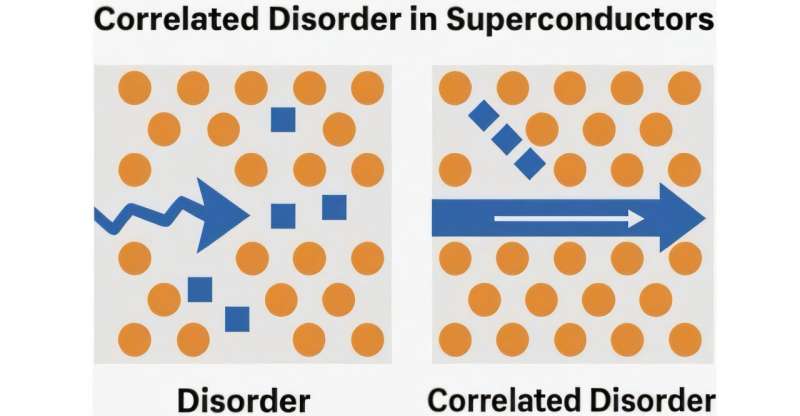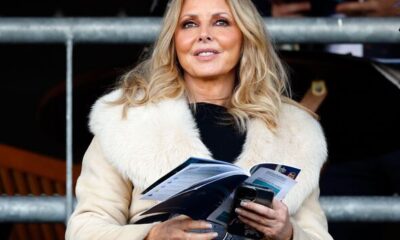Science
New Study Reveals Patterned Defects Enhance Superconductivity

An international team of scientists has discovered that arranging defects within a material in a specific pattern significantly enhances superconductivity. The study, published on July 24, 2025, in the journal Physical Review B, includes contributions from physicists at the National Research University Higher School of Economics (HSE MIEM) and various other institutions.
Superconductivity allows electric current to flow through a material without any energy loss, a phenomenon that traditional conductors cannot achieve. In conventional materials, some energy is dissipated as heat, but superconductors enable current to flow freely. Currently, superconductors are essential in technologies such as MRI machines due to their ability to generate strong magnetic fields. Future applications may include lossless power transmission and high-speed signal processing.
Despite their potential, most superconductors require temperatures below -140 °C to function, limiting their practical applications. Researchers aim to increase their operating temperatures and stability. By controlling the arrangement of defects within the crystal lattice of superconductors, researchers from the HSE MIEM Center for Quantum Metamaterials have shown that superconductivity can be made more robust.
Defects are imperfections within a material’s structure, such as missing atoms or impurities, which typically hinder electron movement and reduce superconductivity. Instead of attempting to eliminate these defects, the research team explored the concept of “correlated disorder,” wherein defects are strategically arranged.
Alexei Vagov, a professor at HSE Tikhonov Moscow Institute of Electronics and Mathematics, likens this to a crowd moving chaotically versus in a coordinated dance. “In superconductors, this kind of order within disorder causes defects to actually enhance superconductivity,” he explains.
The study indicates that superconductivity develops in two stages. Initially, isolated regions of superconductivity emerge, which connect as the temperature lowers, allowing current to flow through the material. The research team modeled a two-dimensional superconductor with varied defect distributions, from random to correlated. Their findings revealed that when disorder is organized rather than chaotic, superconductivity can emerge simultaneously across the entire sample.
These insights could facilitate the creation of thin superconducting films that align with the model used in the study. By controlling defect placement during synthesis, researchers can test their theoretical models and develop materials with desired properties.
Vagov notes, “Controlling the placement of defects at the microscopic level could enable the creation of superconductors that operate at much higher temperatures—potentially even at room temperature. This would transform superconductivity from a laboratory rarity into a technology used in everyday devices.”
This breakthrough holds promise for advancing the field of superconductivity and could lead to significant advancements in various technologies that rely on efficient electrical conduction.
For further details, see the original research: Vyacheslav D. Neverov et al, “Spatial correlations in disorder: Impact on the superconducting critical temperature,” Physical Review B (2025). DOI: 10.1103/PhysRevB.111.184514.
-

 Entertainment3 months ago
Entertainment3 months agoAnn Ming Reflects on ITV’s ‘I Fought the Law’ Drama
-

 Entertainment4 months ago
Entertainment4 months agoKate Garraway Sells £2 Million Home Amid Financial Struggles
-

 Health3 months ago
Health3 months agoKatie Price Faces New Health Concerns After Cancer Symptoms Resurface
-

 Entertainment3 months ago
Entertainment3 months agoCoronation Street’s Carl Webster Faces Trouble with New Affairs
-

 Entertainment3 months ago
Entertainment3 months agoWhere is Tinder Swindler Simon Leviev? Latest Updates Revealed
-

 Entertainment4 months ago
Entertainment4 months agoMarkiplier Addresses AI Controversy During Livestream Response
-

 World2 weeks ago
World2 weeks agoBailey Announces Heartbreaking Split from Rebecca After Reunion
-

 Science1 month ago
Science1 month agoBrian Cox Addresses Claims of Alien Probe in 3I/ATLAS Discovery
-

 Entertainment2 weeks ago
Entertainment2 weeks agoCoronation Street Fans React as Todd Faces Heartbreaking Choice
-

 Health4 months ago
Health4 months agoCarol Vorderman Reflects on Health Scare and Family Support
-

 Entertainment4 months ago
Entertainment4 months agoKim Cattrall Posts Cryptic Message After HBO’s Sequel Cancellation
-

 Entertainment3 months ago
Entertainment3 months agoOlivia Attwood Opens Up About Fallout with Former Best Friend





















